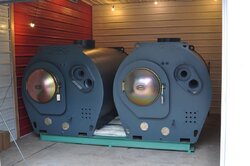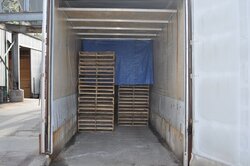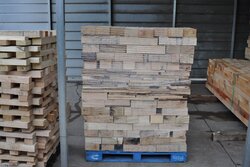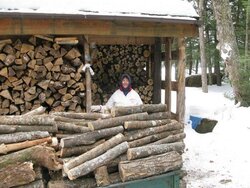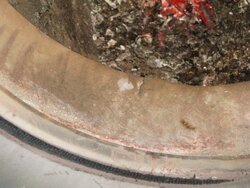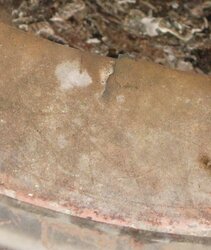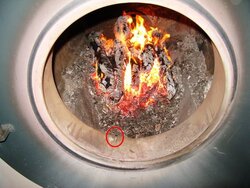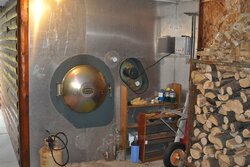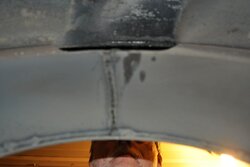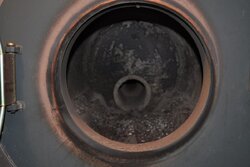I delivered these 2000's, which will be numbers 3 and 4 for this guy last week. He has an older 1450 heating his house and a 1900 currently providing process heat for his application. The 2 new ones will power an expansion of production at his facility. There are a number of interesting things about this job that I thought would be good to share.
I'll start out by describing what's going on at this place. The facility is in Southeast Ohio near Marietta and they recycle wood pallets, taking them in from all over the Easten US. The pallets are all taken apart, broken pieces are discarded and then re-nailed with new braces or slats as needed. Because they come from all over the place, and given the restrictions on moving wood and lumber due to insects, they have to be "sterilized" or de-bugged before they can be moved back out. The "debugging" is done with heat. In short.....they cook the little critters. Each load goes into the "building" shown in the picture with the blue tarp hanging halfway down. (This particular building is actually a converted semi trailer. The new Garns will be used for another building to be constructed yet)
Once in the debugging building, they drill a hole in four pallets, spaced evenly throughout the load and insert a thermocouple into each. The 1900 is piped directly to a monster water/air heating coil that is about 7 feet wide and 18" tall, having 8 rows of coils in it. The fans behind this coil will move about 6-7,000 cfm at a very high velocity....blow your hair back velocity.. I have no idea what the capability of the coil is but the owner of the pallet facility says they fire the old Garn flat out when they run it. They fabbed up a "duct" that runs full length of the structure to the loading door area. It has openings at 1/3 and 2/3 also, along with manually adjustable shutters to balance airflow front to back. The blue curtain hanging halfway down keeps the heat from short circuiting back to the ceiling mounted coil. You can see the thermocouple lead hanging out of the pallets on the left. The pallets themselves have to be brought to 140* internal temp and held there for a half hour. The half hour time does not start until the last thermocouple hits the magic number. You can imagine the btu's needed to bring that many tons of wood up to 140*.
A question that I hear frequently is, does a Garn have to be in a heated building? Simple answer, no it does not. The building these two went into is insulated but has no auxiliary heat in it. It measures about 20' front to back and maybe 18' side to side with a 12 foot ceiling. He constructed it out of recycled lumber and used steel panels and simply put batt insulation in the walls. If he had those two up at 180* with no load on them, he could probably shut the door and it would be 2-3 weeks before they got down to critical temps even in the middle of winter.
The second thing is how he addressed the issue of a very uneven floor. As you can see from the picture, he constructed a base made from steel I-beam to compensate for the slope in the concrete. The new Garn building was erected over what used to be outside storage area and it was sloped for drainage. So he adapted to the given circumstances. I thought his approach to insulating under the Garns was unique and worth sharing. He simply took pieces of plywood and cut them to fit on the rails of the I-beam and then placed R-19 batts on top of that. There is probably 6" of slope from the front left corner to the back right corner of the slab and the base he constructed compensates for that.
The additional benefit is that the loading door of the Garns is about 9" higher than normal. This puts everything up at a level where bending over is not required.
Another issue that usually comes up when burning scrap lumber is the size of the fuel itself. Dry pallet slats are not much more than kindling and when you throw a bunch into a wood burner that moves combustion air at the velocity of a Garn, a person can wind up with severe overheating of the steel in the firebox not exposed to water. They address that problem by simply stacking the "fine" stuff so it presents a burn surface similar to a full log rather than a bunch of little pieces of kindling. He learned this after cracking the air collar on the 1900. The fuel for the Garns is palletized .....go figure.... and brought into the Garn building via fork lift. (now that's how to handle a burn load of a few hundred pounds a day!) The slats are mixed with the bulkier stuff you see in the picture and stacked in there pretty densely.
He is not using a plate HX even though there is an elevation change from the Garn's to the coil. He simply designed his piping so he could do a very effective air purge and then sealed it up. Once that is done the pump selected simply has to circulate the water and not provide additional "lift". This allows the actual temperature of the water in the Garn to hit the coil and eliminates the typical temp drop across a plate HX.
Fire away if you have questions.
I'll start out by describing what's going on at this place. The facility is in Southeast Ohio near Marietta and they recycle wood pallets, taking them in from all over the Easten US. The pallets are all taken apart, broken pieces are discarded and then re-nailed with new braces or slats as needed. Because they come from all over the place, and given the restrictions on moving wood and lumber due to insects, they have to be "sterilized" or de-bugged before they can be moved back out. The "debugging" is done with heat. In short.....they cook the little critters. Each load goes into the "building" shown in the picture with the blue tarp hanging halfway down. (This particular building is actually a converted semi trailer. The new Garns will be used for another building to be constructed yet)
Once in the debugging building, they drill a hole in four pallets, spaced evenly throughout the load and insert a thermocouple into each. The 1900 is piped directly to a monster water/air heating coil that is about 7 feet wide and 18" tall, having 8 rows of coils in it. The fans behind this coil will move about 6-7,000 cfm at a very high velocity....blow your hair back velocity.. I have no idea what the capability of the coil is but the owner of the pallet facility says they fire the old Garn flat out when they run it. They fabbed up a "duct" that runs full length of the structure to the loading door area. It has openings at 1/3 and 2/3 also, along with manually adjustable shutters to balance airflow front to back. The blue curtain hanging halfway down keeps the heat from short circuiting back to the ceiling mounted coil. You can see the thermocouple lead hanging out of the pallets on the left. The pallets themselves have to be brought to 140* internal temp and held there for a half hour. The half hour time does not start until the last thermocouple hits the magic number. You can imagine the btu's needed to bring that many tons of wood up to 140*.
A question that I hear frequently is, does a Garn have to be in a heated building? Simple answer, no it does not. The building these two went into is insulated but has no auxiliary heat in it. It measures about 20' front to back and maybe 18' side to side with a 12 foot ceiling. He constructed it out of recycled lumber and used steel panels and simply put batt insulation in the walls. If he had those two up at 180* with no load on them, he could probably shut the door and it would be 2-3 weeks before they got down to critical temps even in the middle of winter.
The second thing is how he addressed the issue of a very uneven floor. As you can see from the picture, he constructed a base made from steel I-beam to compensate for the slope in the concrete. The new Garn building was erected over what used to be outside storage area and it was sloped for drainage. So he adapted to the given circumstances. I thought his approach to insulating under the Garns was unique and worth sharing. He simply took pieces of plywood and cut them to fit on the rails of the I-beam and then placed R-19 batts on top of that. There is probably 6" of slope from the front left corner to the back right corner of the slab and the base he constructed compensates for that.
The additional benefit is that the loading door of the Garns is about 9" higher than normal. This puts everything up at a level where bending over is not required.
Another issue that usually comes up when burning scrap lumber is the size of the fuel itself. Dry pallet slats are not much more than kindling and when you throw a bunch into a wood burner that moves combustion air at the velocity of a Garn, a person can wind up with severe overheating of the steel in the firebox not exposed to water. They address that problem by simply stacking the "fine" stuff so it presents a burn surface similar to a full log rather than a bunch of little pieces of kindling. He learned this after cracking the air collar on the 1900. The fuel for the Garns is palletized .....go figure.... and brought into the Garn building via fork lift. (now that's how to handle a burn load of a few hundred pounds a day!) The slats are mixed with the bulkier stuff you see in the picture and stacked in there pretty densely.
He is not using a plate HX even though there is an elevation change from the Garn's to the coil. He simply designed his piping so he could do a very effective air purge and then sealed it up. Once that is done the pump selected simply has to circulate the water and not provide additional "lift". This allows the actual temperature of the water in the Garn to hit the coil and eliminates the typical temp drop across a plate HX.
Fire away if you have questions.


